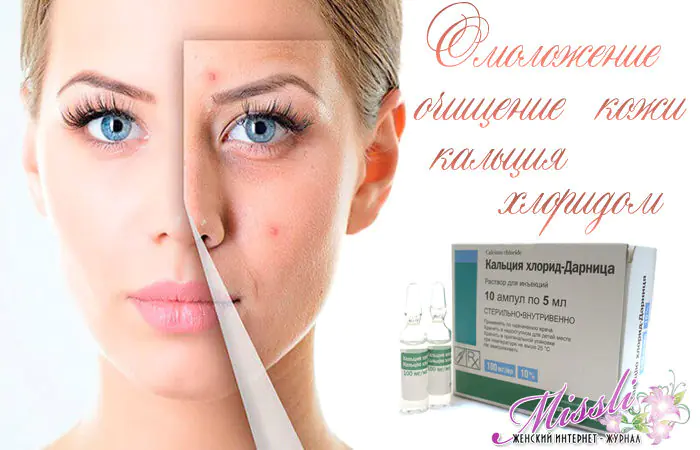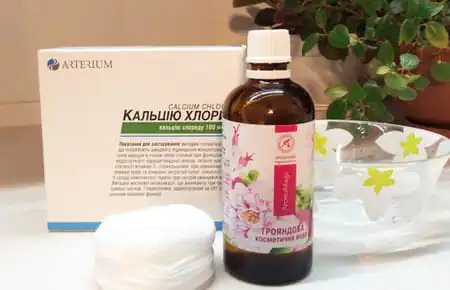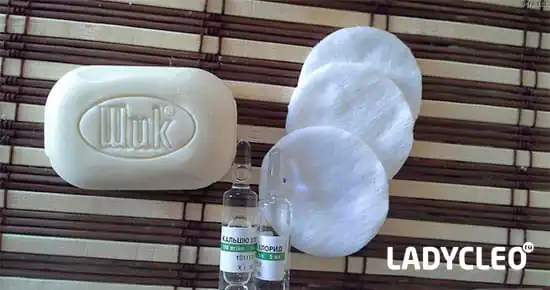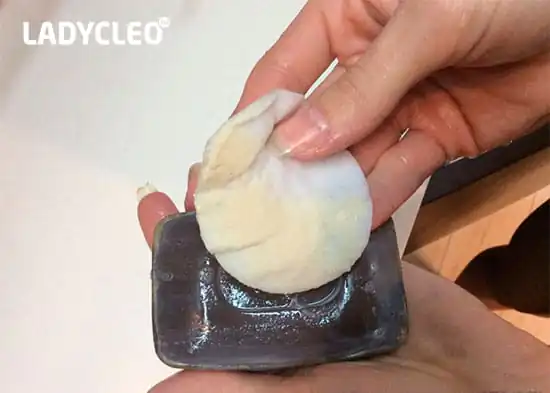
Description and beneficial properties of the substance
Peeling using calcium chloride is available for carrying out the procedure at home due to the low cost of the drug and simple recipes for preparing the composition. This method of deep skin cleansing is suitable for almost everyone, with the exception of cases of individual intolerance to the substance.
As a result of the action of potassium salt crystals on the surface of the skin, the following processes occur:
- Not only the upper, but also the deep layers of the epidermis are cleansed.
- dead particles are removed from the surface of the skin;
- Blackheads disappear, pores narrow and fine wrinkles smooth out.
Despite the great popularity of cosmetic masks with calcium chloride, the drug has a number of contraindications for use, including:
- acne and inflammation;
- skin diseases of viral origin;
- thin, dry and light skin, sensitive to chemicals;
- period of lactation and childbearing;
- individual intolerance to the drug.
Before applying the mask, it is recommended to test for possible allergic reactions. To do this, treat a small area in the wrist area with the composition purchased at the pharmacy and wait about 15 minutes. If no rash or irritation appears on the surface of the skin, you can begin preparing the mixture according to one of the selected recipes.
Facial masks and peelings prepared on the basis of calcium chloride can be used if you have the following problems with the epidermis:
- Numerous blackheads on the face.
- Clogged pores.
- Flaky skin.
- Small wrinkles on the face.
The cleansing procedure is performed no more than once every seven days, the course of treatment is 30 days. It is very important to strictly follow the dosages and timing specified in the recipes to avoid side effects, such as disturbances in the production of melanocytes, which leads to the appearance of age spots. Cosmetologists recommend adhering to the following rules:
- A mask with calcium chloride is applied only to thoroughly cleansed skin.
- For enlarged pores and increased sebum secretion, the intensity of procedures with calcium chloride is once a week, and the drug is not used in its pure form, but diluted with water.
- For skin prone to frequent rashes and acne, one procedure every two weeks will be sufficient. Peeling is carried out if there are no acute inflammations and acne.
- For normal skin type, you can peel with chloride once every 2-3 weeks.
- Even on your own, at home, with the help of properly performed chemical peeling, you can dry and cleanse the skin of keratinized epidermal cells, make the texture smoother and prevent the appearance of subcutaneous acne.

- Anti acne
The recipe is recommended for those who want to cure subcutaneous acne or prevent their appearance. Pre-treat your face with any antiseptic wash gel and let the skin dry a little. Then gently moisten your fingertips in a solution of calcium chloride (10%) and lightly massage the surface of the skin. After this, carefully remove the exfoliated skin particles with water.
- Mask with tar soap
An excellent remedy against oily shine, quickly exfoliates dead epidermal cells and eliminates irritation on chapped areas of the skin. First, treat the skin with tar soap foam, then massage with fingertips moistened in calcium chloride (5%) for 5-10 minutes. After completing the procedure, the face should be rinsed with chamomile infusion and a nourishing cream should be applied.
- Brightening mask with soy mixture
Soy mixture diluted with water until smooth is applied to pre-moistened skin. Wait a little for the layer of soy mixture to dry, then moisten the skin with calcium chloride and carefully roll up the mask. After completing the manipulations, wash your face with cool, clean water. This remedy not only gets rid of freckles and other pigmentation, but also normalizes the functions of the sebaceous glands.
- Cosmetic product with baby soap
Apply evenly to the face with foam made from baby soap and leave for two to three minutes. Then lightly wipe the face with a cotton swab dipped in a chloride solution. After completing the procedure, wash your face with lukewarm water and apply a nourishing cream.
This recipe is recommended as a gentle method of cleansing the skin of dead particles; the product helps get rid of flaking, relieves inflammation and prevents the formation of acne on combination and oily skin.
- Peeling with salt
Suitable for oily skin only. Calcium chloride is applied to the surface of the skin in stages, in five layers, and a three-minute interval should be maintained between the application of each layer.
Then dilute two teaspoons of ordinary salt in a small amount of water and gently massage the skin with the resulting mixture. After removing dead particles, you can wash your face with room water and lubricate your face with cream.
- Rolling mask with soap foam and calcium chloride
A good anti-flaking product that also helps get rid of fine wrinkles. First, treat the skin with a cotton swab moistened in a calcium solution. Apply it in several layers (from 4 to 8 times), with a three-minute interval between each layer. Then distribute soap foam evenly over the surface of the skin and carefully roll it up, observing the direction of the massage lines.
After completing the procedure, wash your face with cool water and generously lubricate the skin with nourishing cream.
- Recipe with oil and chamomile infusion
Cosmetologists advise using this recipe for inflammation on oily and combination skin, prone to acne and purulent pimples. First, lubricate the face with washing gel, then massage it with a mixture of calcium chloride and chamomile decoction (take a small amount of decoction for two or three ampoules of the drug).
The duration of the procedure is 5 minutes. Then lubricate the skin with chamomile essential oil, and after a quarter of an hour wash with water at room temperature.
- Anti-wrinkle mask with whitening effect
7 layers of calcium chloride are gradually applied to the surface of the skin, and each layer must dry thoroughly before applying the next. Then treat the face with a pre-prepared mixture of two tablespoons of soy, a few drops of lavender oil and a small amount of water.
Roll the mixture off the skin for 5-7 minutes, carefully removing any lumps that have formed. After completing the procedure, wash with warm water and lubricate your face with anti-wrinkle cream.
Useful tips
Before applying calcium chloride to your facial skin, you need to make sure there are no wounds, abrasions or acne marks. Procedures cannot be carried out if there are open wounds on the surface of the skin, since calcium chloride can cause burns.
Mild redness of the skin is considered a normal reaction to interaction with the drug. In most cases, you can get rid of redness using a moisturizer or face mask. If irritation is accompanied by itching and other unpleasant sensations, you need to seek help from a specialist who will help get rid of such consequences.
It is not advisable to treat the area near the eyes and above the upper lip with calcium solution.
Calcium chloride is an effective preparation with a powerful exfoliating and rejuvenating effect. The only condition for obtaining quick results is strict adherence to the rules for using this substance. It is necessary to follow all instructions and recommendations of specialists, and also actively use moisturizing cosmetics after completing the procedures.
Many women, due to lack of time or additional funds, cannot regularly visit a cosmetologist. In this case, the way out of the situation may be to use various pharmaceutical products for home care, which give results no worse than salon procedures. An example of such a technique would be cleansing the face with calcium chloride - a simple, cheap and accessible remedy.

Effect on skin
A solution of calcium chloride is sold in a concentration of 5 or 10%, in ampoules of 10 ml, and is used as a remedy to replenish the deficiency of calcium ions in the body. This drug costs mere pennies, which also contributed to the growth of its popularity as a cosmetic product for use at home. When used externally, it has an anti-inflammatory and cleansing effect on the skin, so this product is suitable for combating increased oiliness of the skin, comedones (blackheads), pimples and blackheads. Calcium chloride has become an alternative to salon procedures not only because of its low cost and availability, but also because of its low percentage of side effects and complications.
A solution of calcium chloride is able to penetrate into the superficial and middle layers of the skin, clean out the pores, dissolving fatty masses. When combined with some other substances (for example, baby or tar soap), it has a pronounced peeling effect, thereby replacing salon superficial and even medium chemical peeling. It is recommended to use this product for age-related changes due to oily skin, enlarged and clogged pores and other similar conditions. Reviews from women who used calcium chloride to cleanse their facial skin indicate the high effectiveness of this product and a small number of adverse reactions.

Before using this drug, most experts recommend checking your body for hypersensitivity to this drug. This is quite simple to do - you need to apply a few drops of calcium chloride solution to the front surface of the forearm or wrist and rub it on the skin. If there is no irritation, redness, or itching within 10-15 minutes, there is no allergy to the drug and it can be used for cosmetic purposes.
Recipes with calcium chloride
There are many wonderful recipes using this pharmaceutical drug, but a huge number of people are faced with a problem even at the purchase stage - what kind of calcium chloride solution is needed. The thing is that ampoules with a 5% solution and 10% are available for sale - and most recipes usually do not indicate what concentration of the active agent is needed. In fact, both types of solution are suitable for cosmetic procedures at home, but if you are using it for the first time, it is better to try a less concentrated version (5% solution). If there were no unpleasant consequences, but you wanted to get a stronger effect, then you can purchase 10% calcium chloride.
General facial cleansing with calcium chloride makes it easy to eliminate problems such as oily shine, flaking, and enlarged pores.
For this method of cleansing your facial skin you will need: tar soap, chamomile infusion, nourishing oil and calcium chloride itself. First, moistened skin is soaped with tar soap until a stable foam appears. After this, the fingertips are moistened in a solution of calcium chloride and rubbed into the skin with light massage movements. The foam, along with the remaining solution, is washed off with chamomile infusion, and the skin is wiped with nourishing oil.

Peeling at home using calcium chloride is probably one of the most popular recipes based on this medicine. To do this, using a cotton pad, apply a layer of 10% calcium chloride solution to a dry and cleansed facial skin surface - then wait until the solution dries. Then apply the next layer in the same way, then another - and so on for 3-5 layers. After this, we wet our fingers in a solution of baby soap (or, alternatively, in a simple salt solution) and rub our face along the massage lines. In this case, pellets should be formed from a film of calcium chloride, which is removed along with superficially located dead cells, the contents of clogged pores and other nasties. It is advisable not to carry out this procedure frequently and perform it no more than once a week.
A more complex combined recipe that includes several components:
- shower gel;
- 5% calcium chloride solution (10-15 ml);
- chamomile decoction;
- chamomile essential oil.
First, a mixture for massage is prepared - a calcium chloride solution is mixed with an equal amount of chamomile decoction. After this, apply a cleansing gel to the entire surface of the face and begin massaging with the prepared solution. If everything was done correctly, pellets will form on the surface of the skin. After the procedure, chamomile essential oil is applied to soothe the skin.
The above methods are considered the most common and have the largest number of positive reviews.
Calcium chloride and recipes based on it can fight not only oily skin and clogged pores - with the right approach, it can also help eliminate more pronounced disorders on the face. For example, such as pimples, blackheads, age spots.
For this method, in addition to calcium chloride, you will also need a soy mixture - but such a procedure effectively lightens pigment disorders, including freckles. A thin layer of soy mixture is applied to the surface of the facial skin and allowed to dry, after which, using fingers dipped in a solution of calcium chloride, the mask is removed along the massage lines. After the procedure, you need to rinse your skin with water and apply a moisturizer.
According to reviews from a large number of women, after using this mask, fine wrinkles are smoothed out, the skin is tightened and rejuvenated. First, you need to apply 7 layers of calcium chloride solution to the surface of the skin - the principle is traditional, that is, we apply a layer, wait for it to dry and apply the next one. After the last, seventh layer has dried, prepare a soy mixture (dilute 1-2 tablespoons of soy with a small amount of water), to which we additionally add a few drops of lavender essential oil. After applying this mixture, dry it for 5-10 minutes and begin to roll out lumps from the mixture - not forgetting to move strictly along the massage lines.
Calcium chloride is a simple and relatively safe remedy, so you can not be afraid to experiment a little and select the most suitable methods for yourself. Just don’t experiment with the frequency of using this remedy - no more than 1-2 times a week, and for some particularly aggressive methods - 1 time every two weeks.
Contraindications to procedures
Another situation when you should not experiment with calcium chloride (or even use it at all) is when there are certain contraindications to its use. There are not many of them, so some people neglect to study them, believing that they relate to the use of the drug “as directed”, but not to its use at home. Meanwhile, this is not entirely true, and in a number of conditions, it is better to beware of this drug:
- If you are allergic to the components of the drug, its presence is determined by a simple test, the description of which was given above. It is highly advisable not to neglect such a check - it is better to have a red spot on your hand than a flushed and swollen face.
- Pregnancy and breastfeeding - during this period of a woman’s life it is better to beware of all cosmetic procedures, especially improvised ones - the body’s reaction will be unpredictable.
- Dry sensitive skin - a solution of calcium chloride dries the skin very much (therefore, moisturizers are needed after its use), because of this, it is undesirable to use it for this type of skin.
- Damage and trauma to the skin in the area affected by the drug.
- Herpetic and other infectious skin lesions.
In other cases, the use of home remedies based on calcium chloride is almost unlimited.
Well, let's continue to look for a pill of eternal youth and beauty? Perhaps she will still be found on the pharmacy counter, in the department of inexpensive drugs. We have already smeared Radevit with solcoseryl, applied salicylic acid to the face, and crushed aspirin tablets. But there is still room for experimentation! Meet calcium chloride.
Calcium chloride is used in medicine for injection in the treatment of
- allergies, inflammation, as a hemostatic agent for internal bleeding, and in many other cases.
And mothers and breeders of purebred animals know this solution as a reagent for preparing calcined cottage cheese for children, puppies and kittens.
In cosmetology, this useful substance has found application as a peeling agent. Moreover, domestic cosmetologists have been using peeling with calcium chloride for many years, since the 90s, when it was called “skating ray” or “Hollywood peeling.”
Indications and contraindications
What results are they trying to achieve with the help of the “rolling”? This:
- drying and mattifying oily skin; narrowing and cleansing of pores; renewal of the upper layer of skin; smoothing out small redness and post-acne depressions due to acne (in the absence of fresh rashes and inflammations).
It should be noted that this type of peeling is used only for oily and thick skin. On combination skin it can be performed within the T-zone.
Other contraindications are:
- allergy; herpes; wounds, inflammation, acne
You should not try the product during pregnancy and lactation.
Procedure
For peeling, a pharmaceutical solution of calcium chloride and soap are used.
For the first time, it is better to take a 5% solution (you can buy 10% and dilute it half with boiled water). The soap you use is the simplest, natural, without fragrances, preferably laundry soap, baby soap or tar soap.
Apply the solution to the face with a cotton pad or sponge, rub to obtain a thin, even layer, and wait to dry. When applying, avoid the area above the upper lip and around the eyes.
Then - the next layer, and so on up to 7-8 times. The more layers, the more substance will react, and the higher the potential efficiency (and, accordingly, traumatic) peeling.
The skin tingles a little, but there should not be an unbearable burning sensation.
Then the fingertips are thoroughly soaped and soap foam is applied to the face. Soap reacts with calcium chloride, forming crystals or flakes, which are easily massaged into the skin strictly along the massage lines until it begins to squeak.
After this, the flakes that have rolled up with the upper layer of the epidermis are removed (rolled or shaken off) from the skin, and their remains are washed off with warm water.
There is a second way to carry out this peeling - when, on the contrary, soap foam is first applied, and then calcium chloride is applied to it.
Post-peeling care
After the peeling itself, you can do some more procedures to enhance its effect:
- to narrow pores, you can apply Polysorb to the skin (2 teaspoons of powder mixed with half a spoon of water) for 10–15 minutes; to remove blackheads, use a pulling mask, for example, made from clay with honey; To lighten the skin, make a mask from a soy-based baby formula (2 tablespoons of the mixture per teaspoon of water), apply it for 10–15 minutes, then wash off with a damp sponge.
For example, wash with a decoction of chamomile or calendula, to which a few drops of tea tree or grape seed oil are added. The oil will help restore skin cells damaged by peeling. If it is tea tree oil, then it will also have an antiseptic effect (the skin after peeling becomes alkaline, which can contribute to the development of pathogenic flora on it).
Instead of washing, especially if your skin is not oily, you can apply a nourishing mask based on chamomile decoction, banana pulp or steamed oatmeal, with the addition of a few drops of the same tea tree oil.
Then, a few minutes after peeling, you need to smear your face moisturizing, nourishing cream (preferably with a calming effect), it will relieve or reduce the feeling of tightness.
It is recommended to wipe your face with olive oil for two days.
Result on oily and dry skin
Peeling gives a good effect on young, oily, thick skin with enlarged pores and open comedones (blackheads), but without acne. Judging by the reviews, its owners
- pores narrow, the skin becomes smooth and elastic to the touch, looseness and sponginess decrease or disappear.
The fact is that when calcium chloride reacts with soap (alkali), a plaque forms on the skin, which cannot be completely washed off; it tightens the skin and even gives some visual lifting effect. Largely due to the same plaque, temporary lightening is achieved.
Peeling is very drying and dehydrating - oily skin becomes matte as a result.
On dry skin are formed
- strong, persistent redness, irritation, burns, sometimes even crusts, and the feeling of dryness and tightness is simply unbearable.
Cosmetologists' opinion
Most cosmetologists are skeptical about peeling, considering it to be the domain of students: they are desperate, their skin is young, and they have little money.
Several years ago, this peeling was indeed widely used in domestic cosmetology and at that time was considered very effective. However, in the salon “roll”, calcium chloride of higher concentrations and cosmetic soap were used, which was prepared according to a special recipe, with boric and camphor alcohols and glycerin.
Recommendations
If you still decide to take a risk and try this peeling on yourself, be sure to follow the following recommendations, they will help make this rather traumatic procedure safer:
- Peeling is best done in the evening so that by morning the skin calms down and the redness goes away;
- before applying calcium chloride to your face, check the skin's reaction to the product on your wrist;
- when peeling for the first time, use a 5% solution of calcium chloride and apply it in one or two layers, no more;
- Peeling can be done on oily skin no more than once a week, on normal and combination skin - once every ten days;
- If a strong burning sensation occurs, immediately wash off the mixture with plenty of warm water.
And most importantly: make sure that this peel is suitable for your skin type. If this is not so, do not take risks - there will be no result, and problems and unpleasant sensations will certainly arise.
Of course, beauty requires sacrifices, but they should not be meaningless!



